Study on the Support Pressure of Tunnel Face for the Construction of Pipe-Jacking Across Thin Overburden River Channel Based on Mud-Water Balance
Abstract
1. Introduction
2. Theoretical Analysis of Tunnel-Face Support Pressure
2.1. Mechanism of Support Pressure on Tunnel Face During Pipe Jacking
2.2. Theoretical Calculation Principle of Tunnel-Face Support Pressure
- (1)
- The project site strata are homogeneous, continuous, and isotropic. Tunnel-face damage is caused by sliding within the stratum soil body. The soil on the sliding surface obeys the Mohr–Coulomb failure criterion.
- (2)
- The support pressure on the tunnel face is uniformly distributed. Its vertical variation and the effect of seepage from the ground at the tunnel face are not considered.
- (3)
- The circular pipe-jacking tunnel face is simplified to a retaining wall of equal area and no thickness.
- (4)
- When the pipe-jacking tunnel face is damaged, there is a wedge-shaped block in front. The effect of friction on the contact surface of the wedge block is neglected, the wedge block does not undergo internal deformation, and the static equilibrium condition is satisfied.
2.3. Pressure Calculation and Analysis of Optimal Support Pressure Value
3. Numerical Simulation and Analysis of Support Pressure on Tunnel Face
3.1. Simulation Model and Basic Assumptions
- (1)
- Each stratum was assumed to be ideally elasticoplasticity. The numerical simulation model only considered the soil settlement caused by self-weight and the pipe-jacking process and ignored the effects of underground water, as well as consolidation settlement of the soil.
- (2)
- The soil pressure was considered a circular distributed load acting on the tunnel face. It was assumed that the gap grouting units around the perimeter of the pipe were distributed in equal thicknesses along the radial direction of the pipe sheet (the modulus of elasticity was taken as 1/50 of the in situ stratigraphic unit, and the thickness of the grouted iso-surrogate layer was 2 cm). Friction between the pipe and soil was achieved by setting a coefficient of friction on the contact surface (the friction between the pipe and soil was a certain value and was uniformly distributed along the pipe-jacking direction). The model ignored the effect of grouting pressure on the construction process and the pipe joints. The jacking pressure was taken from the lateral static soil pressure at the center point of the pipe’s tunnel face, as 88.5 kPa. The friction between the pipe and soil was taken as 3.5 kPa.
3.2. Simulation Conditions and Implementation Steps
- (1)
- The basic numerical model was established. Material properties were assigned, and corresponding displacement boundary conditions were imposed. Ground stress equilibrium calculations were performed under initial stress conditions that were designed to simulate the initial ground stress state.
- (2)
- Support pressure equal to the resistance applied in front of the tunnel face was set. The next step was to simulate the disturbance caused by the jacking to the strata ahead until a steady state was reached.
- (3)
- In actual construction, pipe jacking excavates to the bottom of the river channel. The soil is removed, and the pipe support structure is activated. At the same time, an excavation process can be completed by setting up a support pressure applied to the tunnel face.
- (4)
- The overall deformation of the tunnel face and the displacement changes at the corresponding monitoring points were observed and recorded.
- (5)
- According to the support pressure ratio , the magnitude of the mud–water pressure applied at the center point of the tunnel face was altered. Re-excavation calculations were carried out, and the overall deformation of the tunnel face, as well as the displacement changes at the corresponding monitoring points, were observed and recorded.
3.3. Analysis of Calculation Results
4. Engineering Case Study
4.1. Engineering Background
4.2. Comparative Analysis and Discussion of Engineering Effects
5. Conclusions
- (1)
- The damage mechanism of the tunnel face during pipe jacking under conditions of a thin overburden, mud–water equilibrium, and construction crossing a river was examined. Mathematical expressions for the lower and upper limit values of the tunnel-face support pressure, Pmin and Pmax, were derived from analyses of the passive and active damage occurring at the tunnel face of the pipe tunnel, in conjunction with the limit equilibrium method. The jacking area was divided into a non-river impact area and a river impact area. Mathematical expressions for the optimal support pressure values, Po1 and Po2, for the two areas were also given separately.
- (2)
- By studying the Y25-Y26 pipe-jacking project crossing the Chu River in Hefei North City, and through numerical simulation, the displacement and ultimate support pressure of the tunnel face under different river overburdens and different support ratios were discussed. As the thickness of the overburden decreased, the soil monitoring point displacement caused by the active support pressure continued to increase, while the displacement caused by the passive support pressure continued to decrease. When large-diameter pipe jacking crosses a river channel, if the overburden thickness is small, the setting of the support pressure requires a reduced support ratio, while the support ratio needs to be increased if the overburden thickness is large. The optimal support force is in the interval of = 1.0~1.5 when = 3 m, in the interval of = 0.9~1.0 when = 2 m, and in the interval of = 0.8~0.9 when = 1 m.
- (3)
- For pipe jacking crossing a thin-cover river channel, the theoretically calculated upper limit value Pmax, lower limit value Pmin, and optimal value Po and the numerically simulated limit value of the support pressure were 2669.977 kN, 309.910 kN, 1044.870 kN, and 881.786 kN, respectively. The values measured during pipe jacking fluctuated between the upper limit value Pmax and the lower limit value Pmin. They were more similar to the optimal value Po in the non-river impact area and more similar to the upper limit value Pmax in the river impact area. To overcome the complexity of geological conditions, the limitations of mechanical equipment, and other factors to ensure the stability of the tunnel face without damage, it is necessary to set the tunnel-face support pressure within a reasonable range between the upper limit value Pmax and the lower limit value Pmin; we suggest adopting the optimal value Po. The analysis will make it possible in the future to develop longitudinally in pipe-jacking construction. The evolution characteristics of support pressure and damage alarm of a tunnel face under complex conditions should be more greatly explored and tested in practice in combination with artificial intelligence and algorithms.
Author Contributions
Funding
Institutional Review Board Statement
Informed Consent Statement
Data Availability Statement
Acknowledgments
Conflicts of Interest
References
- Chen, P.; Liu, X.; Deng, Z.; Liang, N.; Du, L.; Du, H.; Huang, Y.; Deng, L.; Yang, G. Study on the pipe friction resistance in long-distance rock pipe jacking engineering. Undergr. Space 2023, 9, 173–185. [Google Scholar] [CrossRef]
- Hsiung, B.-C.B.; Yang, K.-H.; Aila, W.; Ge, L. Evaluation of the wall deflections of a deep excavation in Central Jakarta using three-dimensional modeling. Tunn. Undergr. Space Technol. 2018, 72, 84–96. [Google Scholar] [CrossRef]
- Georgiou, D.; Kalos, A.; Kavvadas, M. 3D Numerical Investigation of Face Stability in Tunnels With Unsupported Face. Geotech. Geol. Eng. 2022, 40, 355–366. [Google Scholar] [CrossRef]
- Ji, X.; Ni, P.; Barla, M. Analysis of jacking forces during pipe jacking in granular materials using particle methods. Undergr. Space 2019, 4, 277–288. [Google Scholar] [CrossRef]
- Chen, R.; Yin, X.; Tang, L.; Chen, Y. Centrifugal model tests on face failure of earth pressure balance shield induced by steady state seepage in saturated sandy silt ground. Tunn. Undergr. Space Technol. 2018, 81, 315–325. [Google Scholar] [CrossRef]
- Lu, B.; Jia, P.; Zhao, W.; Zheng, Q.; Du, X.; Tang, X. Longitudinal mechanical force mechanism and structural design of steel tube slab structures. Tunn. Undergr. Space Technol. 2023, 132, 104883. [Google Scholar] [CrossRef]
- Chen, R.-p.; Li, J.; Kong, L.-g.; Tang, L.-j. Experimental study on face instability of shield tunnel in sand. Tunn. Undergr. Space Technol. 2013, 33, 12–21. [Google Scholar] [CrossRef]
- Bengt, B.B.; Bennermark, H. Stability of Clay at Vertical Openings. J. Soil Mech. Found. Div. 1967, 96, 71–94. [Google Scholar] [CrossRef]
- Peck, R.B.; Hendron, A.J.; Mohraz, B. Deep excavations and tunneling in soft ground. In Proceedings of the 7th International Conference on Soil Mechanics and Foundation Engineering, Mexico City, Mexico, 1969; pp. 225–290. Available online: https://trid.trb.org/view/125926 (accessed on 31 March 2025).
- Davis, E.H.; Gunn, M.J.; Mair, R.J.; Seneviratine, H.N. The stability of shallow tunnels and underground openings in cohesive material. Géotechnique 1980, 30, 397–416. [Google Scholar] [CrossRef]
- Leca, E.; Dormieux, L. Upper and lower bound solutions for the face stability of shallow circular tunnels in frictional material. Géotechnique 1990, 40, 581–606. [Google Scholar] [CrossRef]
- Soubra, A.H. Kinematical approach to the face stability analysis of shallow circular tunnels. In Proceedings of the 8th International Symposium on Plasticity, Vancouver, BC, Canada, 17–21 July 2000; Available online: https://hal.science/hal-01008370v1 (accessed on 31 March 2025).
- Li, P.; Wang, F.; Zhang, C.; Li, Z. Face stability analysis of a shallow tunnel in the saturated and multilayered soils in short-term condition. Comput. Geotech. 2019, 107, 25–35. [Google Scholar] [CrossRef]
- Zhang, Y.; Tao, L.; Zhao, X.; Kong, H.; Guo, F.; Bian, J. An analytical model for face stability of shield tunnel in dry cohesionless soils with different buried depth. Comput. Geotech. 2022, 142, 104565. [Google Scholar] [CrossRef]
- Ren, D.-J.; Xu, Y.-S.; Shen, J.S.; Zhou, A.; Arulrajah, A. Prediction of Ground Deformation during Pipe-Jacking Considering Multiple Factors. Appl. Sci. 2018, 8, 1051. [Google Scholar] [CrossRef]
- Zhang, X.; Wang, M.; Wang, Z.; Li, J.; Tong, J.; Liu, D. A limit equilibrium model for the reinforced face stability analysis of a shallow tunnel in cohesive-frictional soils. Tunn. Undergr. Space Technol. 2020, 105, 103562. [Google Scholar] [CrossRef]
- Cornejo, L. Instability at the face: Its repercussions for tunnelling technology. Tunn. Tunn. 1989, 21, 69–74. Available online: http://worldcat.org/issn/0041414X (accessed on 31 March 2025).
- Mollon, G.; Dias, D.; Soubra, A.-H. Rotational failure mechanisms for the face stability analysis of tunnels driven by a pressurized shield. Int. J. Numer. Anal. Methods Geomech. 2011, 35, 1363–1388. [Google Scholar] [CrossRef]
- Senent, S.; Mollon, G.; Jimenez, R. Tunnel face stability in heavily fractured rock masses that follow the Hoek–Brown failure criterion. Int. J. Rock Mech. Min. Sci. 2013, 60, 440–451. [Google Scholar] [CrossRef]
- Ibrahim, E.; Soubra, A.-H.; Mollon, G.; Raphael, W.; Dias, D.; Reda, A. Three-dimensional face stability analysis of pressurized tunnels driven in a multilayered purely frictional medium. Tunn. Undergr. Space Technol. 2015, 49, 18–34. [Google Scholar] [CrossRef]
- Zhang, C.; Han, K.; Zhang, D. Face stability analysis of shallow circular tunnels in cohesive–frictional soils. Tunn. Undergr. Space Technol. 2015, 50, 345–357. [Google Scholar] [CrossRef]
- Chen, G.-H.; Zou, J.-F.; Chen, J.-Q. Shallow tunnel face stability considering pore water pressure in non-homogeneous and anisotropic soils. Comput. Geotech. 2019, 116, 103205. [Google Scholar] [CrossRef]
- Zou, J.; Chen, G.; Qian, Z. Tunnel face stability in cohesion-frictional soils considering the soil arching effect by improved failure models. Comput. Geotech. 2019, 106, 1–17. [Google Scholar] [CrossRef]
- Jancsecz, S.; Steiner, W. Face support for a large Mix-Shield in heterogeneous ground conditions. In Conference Proceeding of Institute of Mining and Metallurgy and British Tunneling Society; Springer: London, UK, 1994. [Google Scholar] [CrossRef]
- Horn, N. Horizontal earth pressure on the vertical surfaces of the tunnel tubes. In Proceedings of the National Conference of the Hungarian Civil Engineering Industry, Budapest, Hungary, 7–16 November 1961. (In German). [Google Scholar]
- Chen, R.P.; Tang, L.J.; Yin, X.S.; Chen, Y.M.; Bian, X.C. An improved 3D wedge-prism model for the face stability analysis of the shield tunnel in cohesionless soils. Acta Geotech. 2015, 10, 683–692. [Google Scholar] [CrossRef]
- Vermeer, P.; Ruse, N.; Dolatimehr, A. Tunnel Heading Stability in Drained Ground. Felsbau 2002, 20. Available online: https://www.uni-stuttgart.de/igs/content/publications/67.pdf (accessed on 31 March 2025).
- Perazzelli, P.; Anagnostou, G. Analysis Method and Design Charts for Bolt Reinforcement of the Tunnel Face in Purely Cohesive Soils. J. Geotech. Geoenviron. Eng. 2017, 143, 04017046. [Google Scholar] [CrossRef]
- Liu, W.; Tan, J.; Shi, J.; Huang, X.; Chen, W. A Method for calculating jacking force of parallel pipes considering Soil Arching Effect and Pipe-Slurry-Soil Interaction. Comput. Geotech. 2024, 173, 106528. [Google Scholar] [CrossRef]
- Molnar, K.M.; Finno, R.J.; Rossow, E.C. Analysis of Effects of Deep Braced Excavations on Adjacent Buried Utilities. 2003. Available online: https://trid.trb.org/view/696546 (accessed on 31 March 2025).
- Lee, K.M.; Rowe, R.K. Finite element modelling of the three-dimensional ground deformations due to tunnelling in soft cohesive soils: Part I—Method of analysis. Comput. Geotech. 1990, 10, 87–109. [Google Scholar] [CrossRef]
- Beer, G.; Watson, J.O.; Swoboda, G. Three-dimensional analysis of tunnels using infinite boundary elements. Comput. Geotech. 1987, 3, 37–58. [Google Scholar] [CrossRef]
- Kirsch, A. Experimental investigation of the face stability of shallow tunnels in sand. Acta Geotech. 2010, 5, 43–62. [Google Scholar] [CrossRef]
- Mair, R.J.; Taylor, R.N. Bored Tunnelling in the Urban Environment. In Proceedings of the Fourteenth International Conference on Soil Mechanics and Foundation Engineering, Rotterdam, The Netherlands, 6–12 September 1997. [Google Scholar]
- Liu, Q.-W.; Yang, Z.-N. Model test research on excavation face stability of slurry balanced shield in permeable sand layers. Chin. Rock Soil Mech. 2014, 35, 2255–2260. [Google Scholar] [CrossRef]
- Cheng, R.; Qi, L.; Tang, L.; Zhou, B. Study of Limit Supporting Force of Excavtion Face’s Passive Failure of Shield Tunnels in Sand Strata. Chin. J. Rock Mech. Eng. 2013, 32, 2877–2882. [Google Scholar]
- Wei, G.; He, F. Calculation of Minimal Support Pressure Acting on Shield Faceduring Pipe Jacking in Sand Soil. Chin. J. Undergr. Space Eng. 2007, 3, 903–908. [Google Scholar]
- Zhang, Z.; Mao, R.; Zhang, J.; Wang, X.; Zhang, M. Study on the Division of the Affected Zone under Construction Unloading and Its Construction Sequence of the Multiline Parallel River-Crossing Pipe Jacking. Adv. Civ. Eng. 2023, 2023, 1–17. [Google Scholar] [CrossRef]
- Tang, J.; Xu, J.; Zhou, D.; Huang, D.; Zeng, K.; Li, Y.; Chen, Z. Ground Surface Deformation Caused by Pipe Jacking Construction in a Soft Soil Area: An Experiment-Based Study. Buildings 2023, 13, 1628. [Google Scholar] [CrossRef]
- Wang, Y.; Zhang, D.; Fang, Q.; Liu, X.; Wang, J. Analytical Solution on Ground Deformation Caused by Parallel Construction of Rectangular Pipe Jacking. Appl. Sci. 2022, 12, 3298. [Google Scholar] [CrossRef]
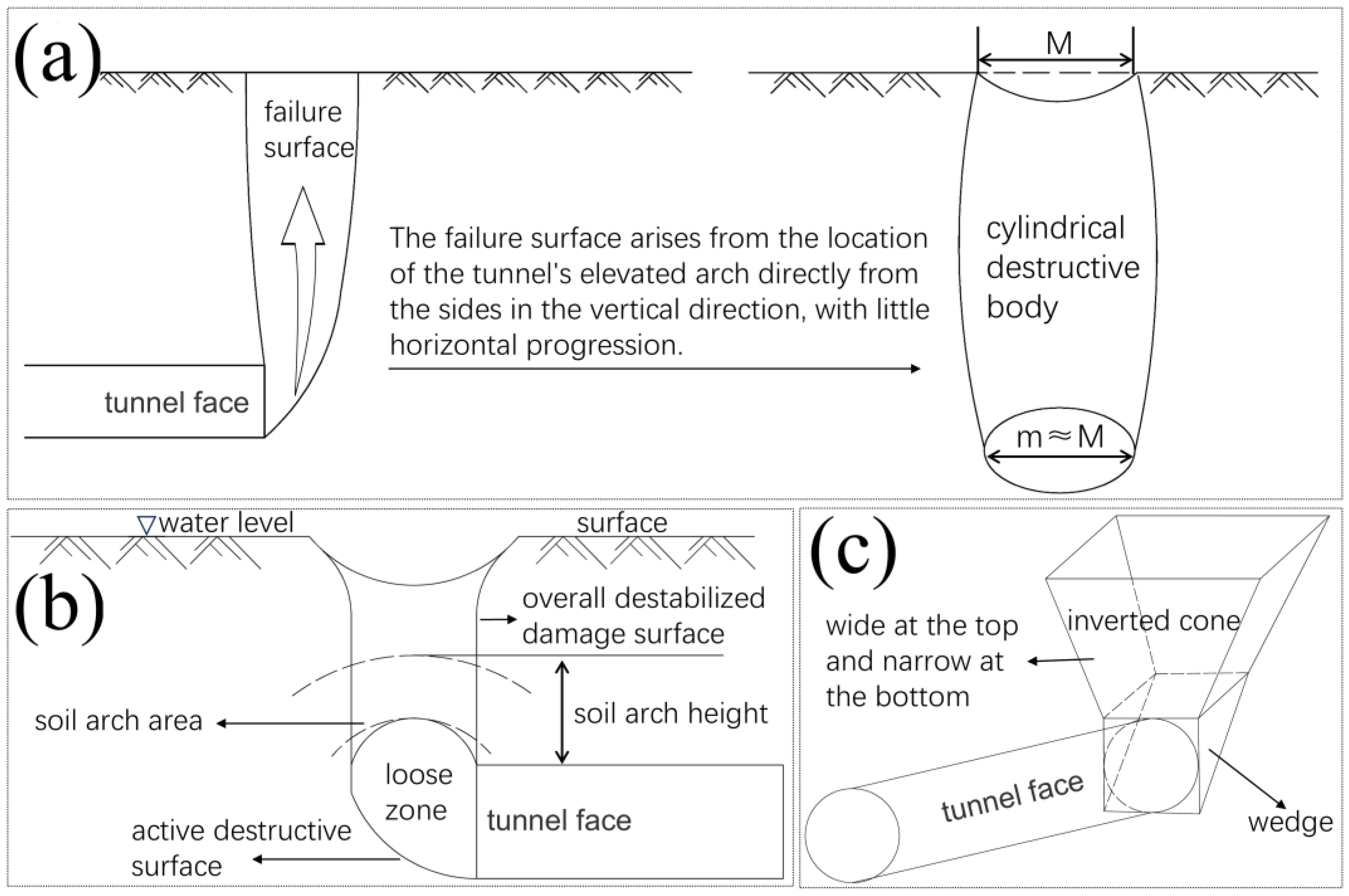

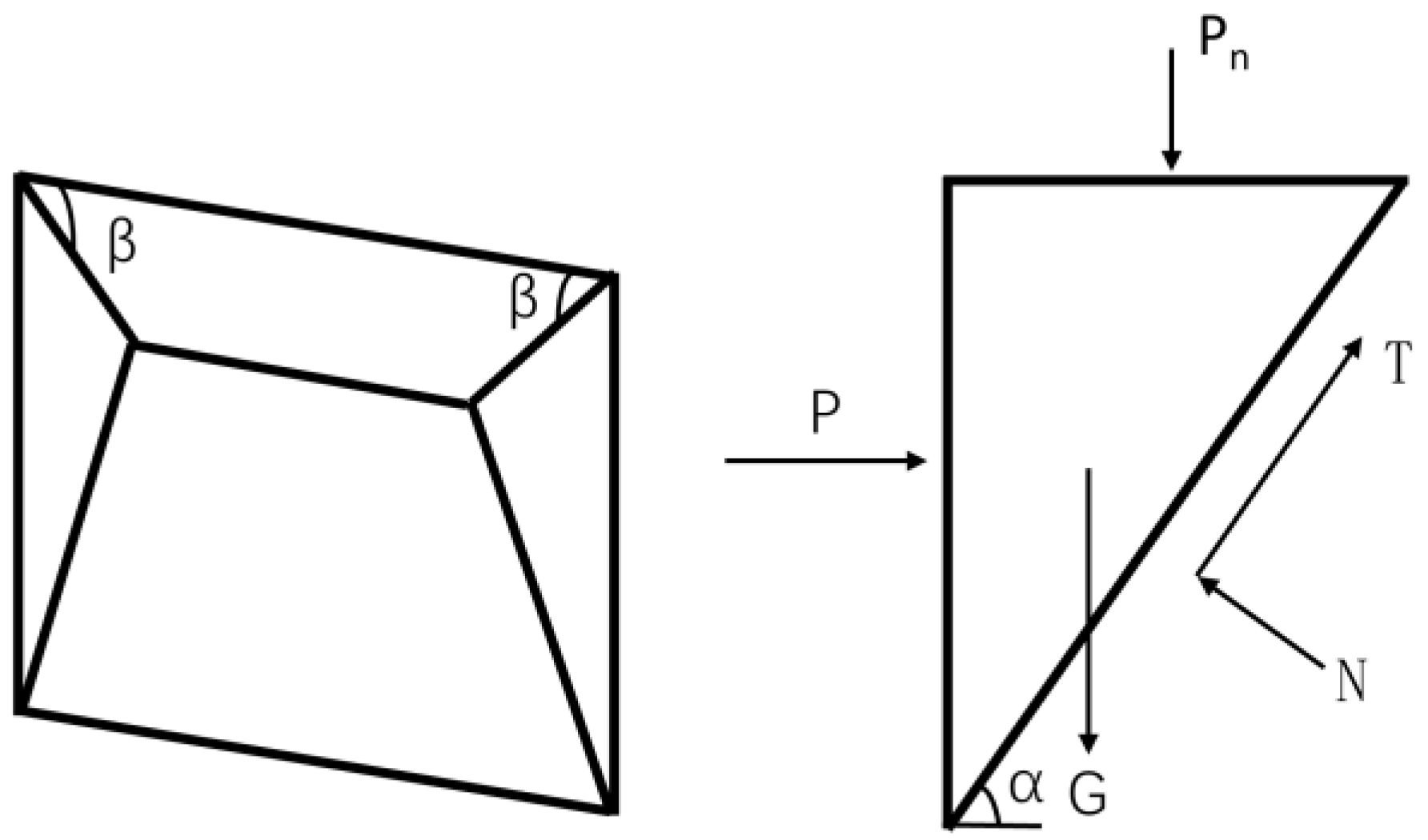

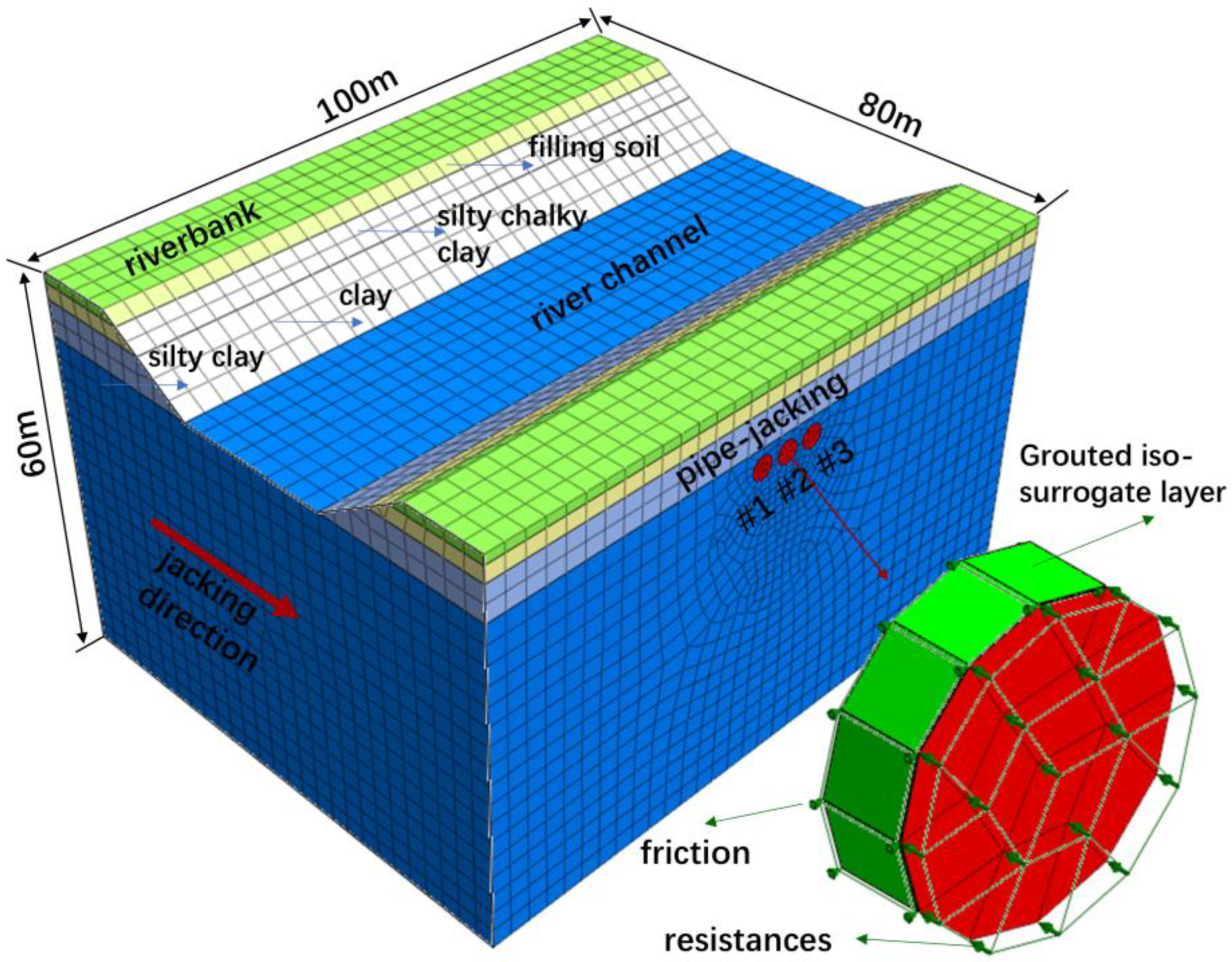
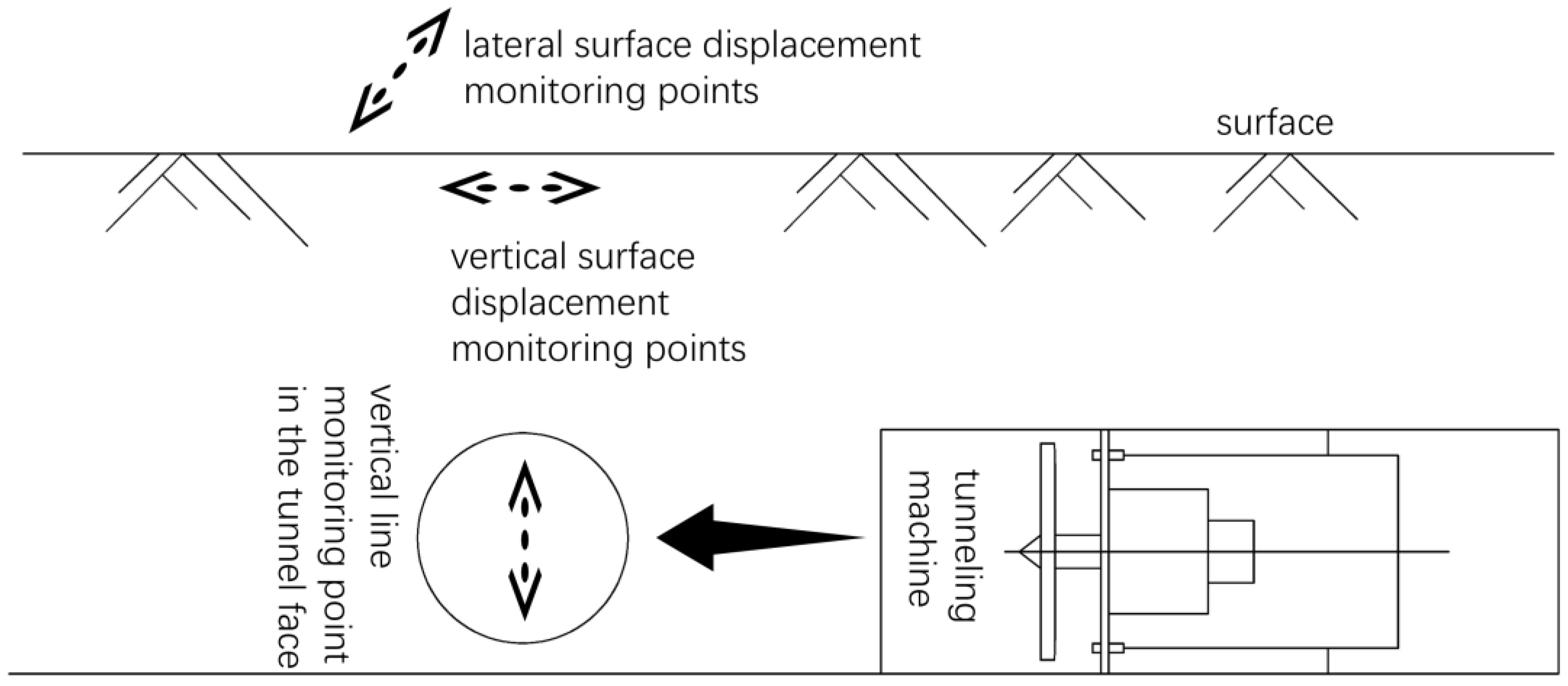



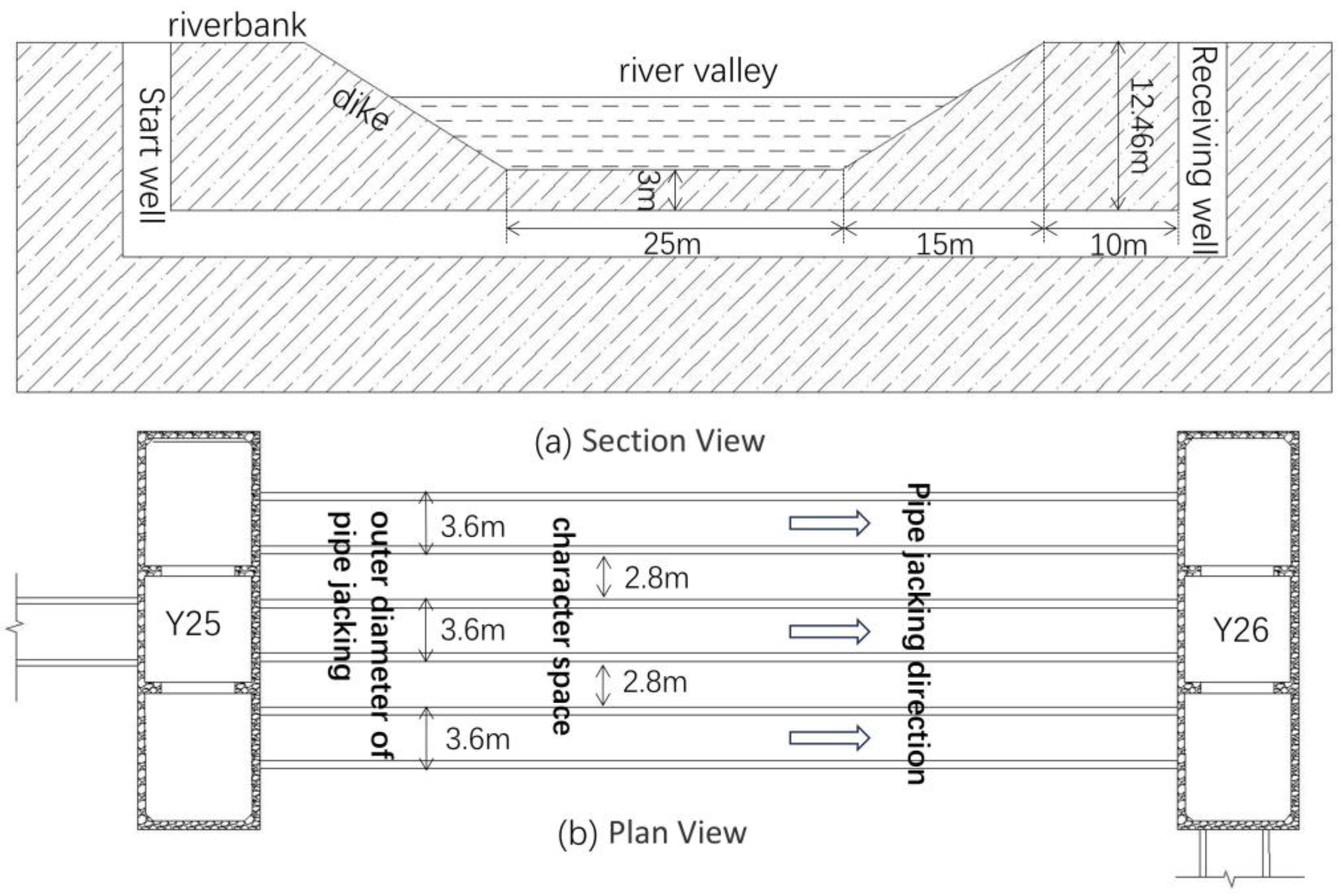
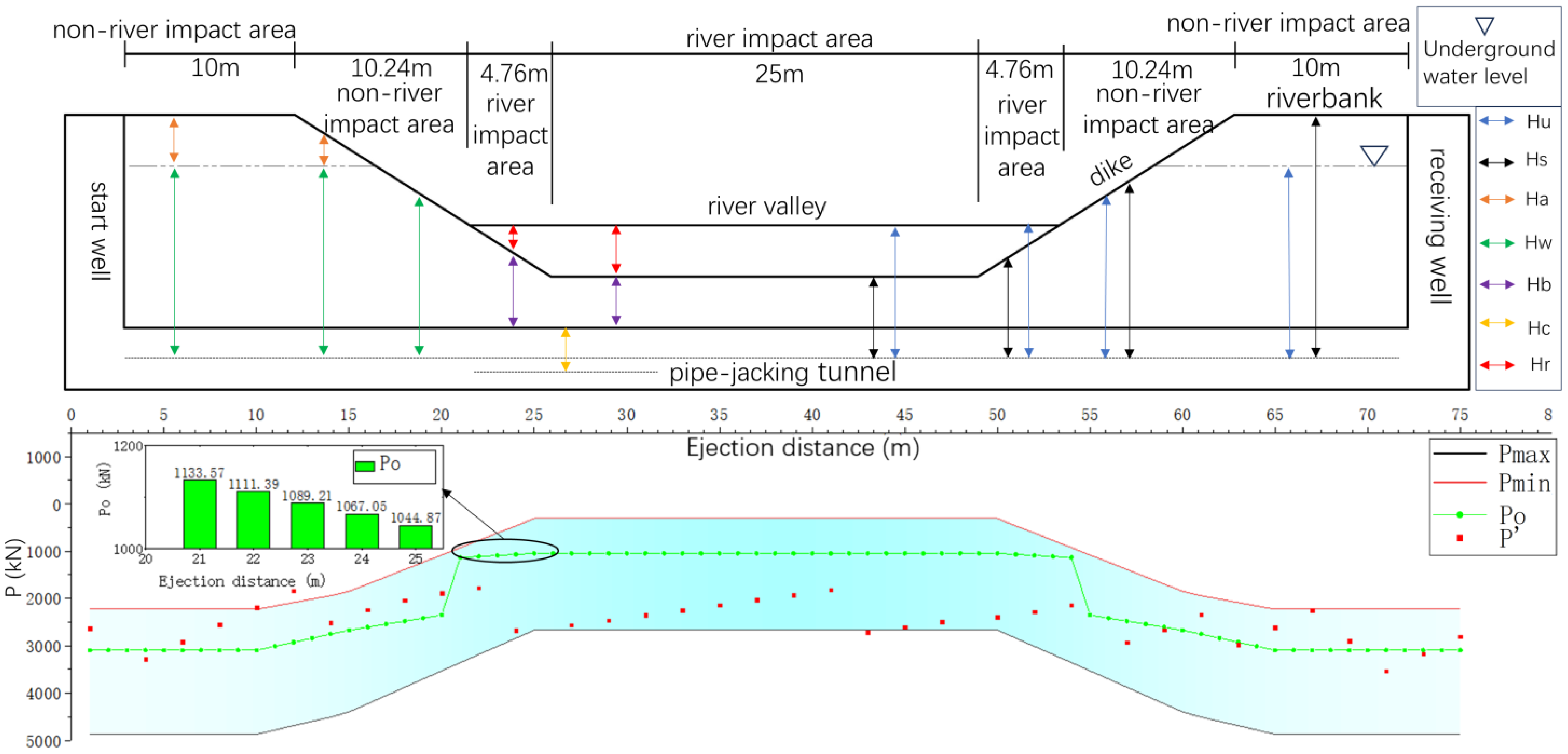
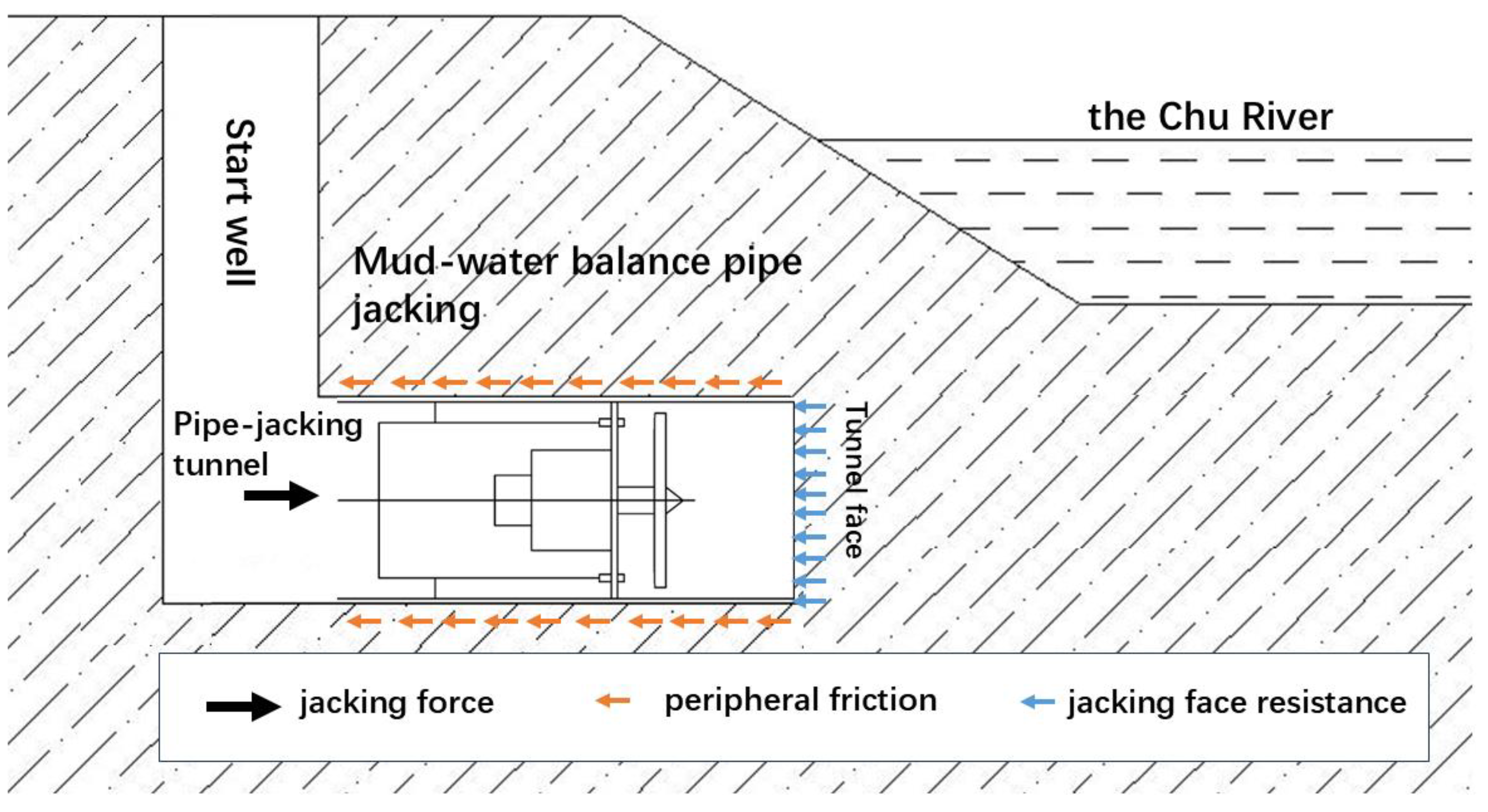
| Material Type | Elastic Modulus E (MPa) | Poisson’s Ratio | Volumetric Weight γ (kN/m3) | Thickness (m) |
|---|---|---|---|---|
| Reinforced concrete | 28,000 | 0.2 | 23 | 0.3 |
| Digging machine housings | 206,000 | 0.3 | 78.5 | 0.06 |
| Parameter Type | Elastic Modulus E (MPa) | Poisson’s Ratio | Cohesive Force c (kPa) | Angle of Internal Friction φ (°) | Volumetric Weight γ (kN/m3) | Thickness (m) |
|---|---|---|---|---|---|---|
| Filling soil | 8.0 | 0.27 | 10 | 10.0 | 18.00 | 0.5~1.5 |
| Silty chalky clay | 3.2 | 0.27 | 6.2 | 5.8 | 17.52 | 1.2~2.7 |
| Clay | 12.0 | 0.25 | 70 | 16.9 | 19.22 | 5.9~7.5 |
| Silty clay | 11.3 | 0.25 | 40 | 15.5 | 19.22 | 4.8~6.0 |
| Case | Ⅰ | Ⅱ | Ⅲ |
|---|---|---|---|
| Thickness of overburden (m) | 3.00 | 2.00 | 1.00 |
| Theoretical value of support pressure (kPa) | 88.5 | 74.3 | 60.0 |
| Support Ratio λ | 0.5 | 0.6 | 0.7 | 0.8 | 0.9 | 1.0 | 1.5 | 2.0 | 2.5 | 3.0 | 3.5 | |
|---|---|---|---|---|---|---|---|---|---|---|---|---|
| Support pressure/kPa | 44.25 | 53.10 | 61.85 | 70.80 | 79.65 | 88.50 | 132.75 | 177.00 | 221.25 | 265.50 | 309.75 | |
| 37.15 | 44.58 | 52.01 | 59.44 | 66.87 | 74.30 | 111.45 | 148.6 | 185.75 | 222.9 | 260.05 | ||
| 30 | 36 | 42 | 48 | 54 | 60 | 90 | 120 | 150 | 180 | 210 | ||
| Jacking Distances (m) | Upper Limit Value Pmax (kN) | Lower Limit Value Pmin (kN) | Optimal Value Po (kN) |
|---|---|---|---|
| 1–10 | 4868.249 | 2230.598 | 3098.977 |
| 11 | 4777.464 | 2158.328 | 3012.564 |
| 12 | 4686.679 | 2086.059 | 2926.288 |
| 13 | 4596.038 | 2013.904 | 2839.876 |
| 14 | 4505.253 | 1941.634 | 2753.463 |
| 15 | 4394.509 | 1849.406 | 2672.566 |
| 16 | 4222.220 | 1695.603 | 2608.338 |
| 17 | 4049.658 | 1541.555 | 2544.110 |
| 18 | 3877.368 | 1387.752 | 2479.984 |
| 19 | 3704.806 | 1233.705 | 2415.755 |
| 20 | 3532.243 | 1079.658 | 2351.527 |
| 21 | 3359.954 | 925.855 | 1133.573 |
| 22 | 3187.391 | 771.807 | 1111.388 |
| 23 | 3014.829 | 617.760 | 1089.204 |
| 24 | 2842.540 | 463.957 | 1067.055 |
| 25–50 | 2669.977 | 309.910 | 1044.870 |
| Jacking Distances (m) | Jacking Force (kN) | Measured Value P′ (kN) | Jacking Distances (m) | Jacking Force (kN) | Measured Value P′ (kN) |
|---|---|---|---|---|---|
| 2 | 3000 | 2639 | 41 | 6000 | 1926 |
| 4 | 4000 | 3278 | 43 | 6000 | 1819 |
| 6 | 4000 | 2917 | 45 | 7000 | 2712 |
| 8 | 4000 | 2556 | 47 | 7000 | 2605 |
| 10 | 4000 | 2195 | 49 | 7000 | 2498 |
| 12 | 4000 | 1834 | 51 | 7000 | 2391 |
| 14 | 5000 | 2509 | 53 | 7000 | 2284 |
| 16 | 5000 | 2242 | 55 | 7000 | 2137 |
| 18 | 5000 | 2036 | 57 | 8000 | 2930 |
| 20 | 5000 | 1889 | 59 | 8000 | 2264 |
| 22 | 5000 | 1782 | 61 | 8000 | 2338 |
| 24 | 6000 | 2675 | 63 | 9000 | 2977 |
| 26 | 6000 | 2568 | 65 | 9000 | 2616 |
| 28 | 6000 | 2461 | 67 | 9000 | 2255 |
| 30 | 6000 | 2354 | 69 | 10,000 | 2894 |
| 32 | 6000 | 2247 | 71 | 11,000 | 3533 |
| 35 | 6000 | 2140 | 73 | 11,000 | 3172 |
| 38 | 6000 | 2033 | 75 | 10,000 | 2811 |
Disclaimer/Publisher’s Note: The statements, opinions and data contained in all publications are solely those of the individual author(s) and contributor(s) and not of MDPI and/or the editor(s). MDPI and/or the editor(s) disclaim responsibility for any injury to people or property resulting from any ideas, methods, instructions or products referred to in the content. |
© 2025 by the authors. Licensee MDPI, Basel, Switzerland. This article is an open access article distributed under the terms and conditions of the Creative Commons Attribution (CC BY) license (https://creativecommons.org/licenses/by/4.0/).
Share and Cite
Zhang, Z.; Li, W.; Sheng, J.; Leng, B.; Zhang, M. Study on the Support Pressure of Tunnel Face for the Construction of Pipe-Jacking Across Thin Overburden River Channel Based on Mud-Water Balance. Appl. Sci. 2025, 15, 7060. https://doi.org/10.3390/app15137060
Zhang Z, Li W, Sheng J, Leng B, Zhang M. Study on the Support Pressure of Tunnel Face for the Construction of Pipe-Jacking Across Thin Overburden River Channel Based on Mud-Water Balance. Applied Sciences. 2025; 15(13):7060. https://doi.org/10.3390/app15137060
Chicago/Turabian StyleZhang, Ziguang, Wanyu Li, Jie Sheng, Biao Leng, and Mengqing Zhang. 2025. "Study on the Support Pressure of Tunnel Face for the Construction of Pipe-Jacking Across Thin Overburden River Channel Based on Mud-Water Balance" Applied Sciences 15, no. 13: 7060. https://doi.org/10.3390/app15137060
APA StyleZhang, Z., Li, W., Sheng, J., Leng, B., & Zhang, M. (2025). Study on the Support Pressure of Tunnel Face for the Construction of Pipe-Jacking Across Thin Overburden River Channel Based on Mud-Water Balance. Applied Sciences, 15(13), 7060. https://doi.org/10.3390/app15137060







